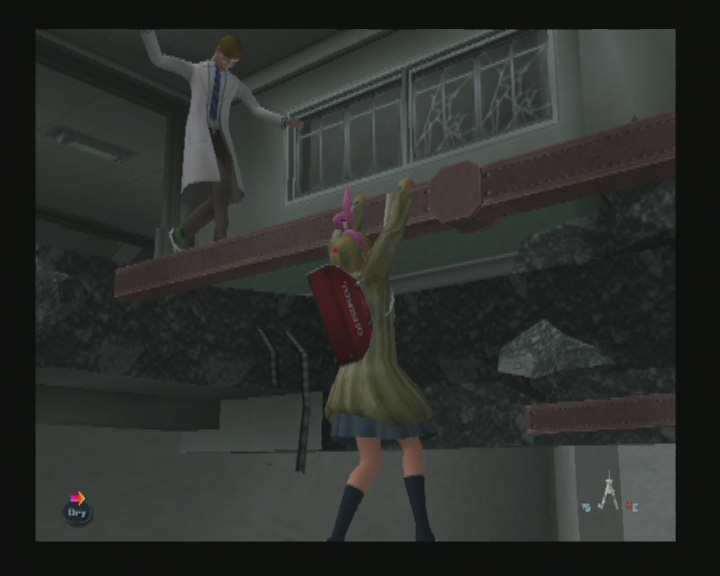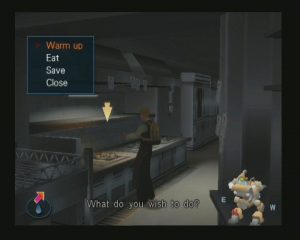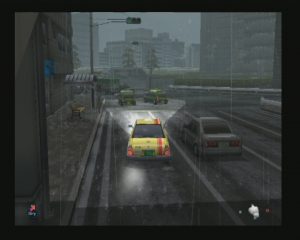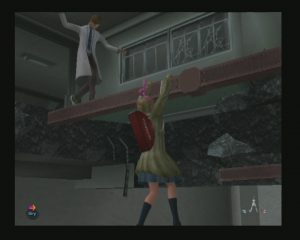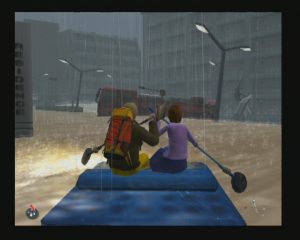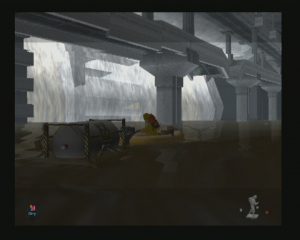The sequel to Disaster Report, localized as Raw Danger! in the west, is bigger, better and far more ambitious than the original. Instead of an earthquake, the disaster centres around a newly constructed city on the banks of the Hudson river, being flooded during heavy rains and in danger of being swept away by a nearby levy. Rather than HP, stamina and water intake, you need to be aware of your body temperature as you try to keep characters dry. All of the mechanics found in Disaster Report, such as clothing, vehicles and item combination, have been improved and expanded. Also, instead of one character with a story branch in the middle which later joins back up, there are five main characters (plus one secret character), each with their own unique but overlapping chapter. There’s even some recurring characters! The chapters build upon each other in layers, so actions done earlier (such as unlocking a door) carry through to affect other characters. In so many ways, it’s the perfect sequel. It retains the feel and atmosphere of the original, while addressing criticisms and shortcomings. For those annoyed by the lack of camera control in Disaster Report, you now have total freedom of control with the right analogue stick, able to pan around characters at will.
The story is also excellent, playing out like a TV serial thriller; the overlapping narrative is the kind of thing seen in series like 24 or film dramas like Crash. What makes it even better is the degree of control you have over the narrative, from simple dialogue choices which are purely cosmetic, to major decisions which decide whether someone lives or dies. Mass Effect gets so much attention for offering branching dialogue with real consequences in an action environment, contrasting against traditional adventures which were doing it years earlier, but really Raw Danger did it first, and perhaps even better. While its visuals and mechanics are rough around the edges, the real-world scenario and moral choices are expertly scripted. There’s no need for an intergalactic set-up – you’re dealing with regular working people and students, in a disaster situation which could well affect you some day. In truth there is a sub-plot involving a deadly virus which could destroy the world, but it’s just in the later chapters. You will come to hate some of these characters, while others you’ll develop a growing fondness for. For a personalised touch you can also rename all the characters.
Again, just like before, Agetec did a bizarre job during localisation by giving everyone blonde hair – even if they’re clearly Asian, such as Mayor Goldstein. Actually, it’s one of the laziest localisation jobs you’ll find, with Agetec leaving Japanese character textures all over the game. It’s amazing this is in English. Hilariously the box art actually shows the two main characters as they looked in the Japanese version! How such a piss-poor publishing house ended up with the rights to Irem’s games is a mystery!
Characters
Joshua Harwell (playable)
The starting character, who looks quite a bit like Keith from Disaster Report, what with his bleached hair. Although a college student he’s earning extra money as a waiter at the Geo City Inaugural Banquet, along with Stephanie McMurrough. When the flooding hits he manages to escape with her, and later can choose to either evacuate via helicopter, or help her find her stepmother, which opens up a whole new section of game. Like in the previous game you can choose to be a complete ass if you want to. Again and again.
Stephanie McMurrough
Daughter of a rich business tycoon and heir to the McMurrough Foundation, she’s working as a waitress to prove her independence. But she also has a dark secret. Her mother died when she was very young, and her father remarried. Despite her stepmother’s best efforts Stephanie resented this, leading to a tragic accident which left the stepmother crippled. Soon afterwards her father got a divorce, leaving Steph with the guilt. It’s worth it to help reconcile her with her stepmother. If Joshua behaves like a gentleman, there may even be a future for the two of them…
Mayor Goldstein
The guy behind the development of Geo City. You see him at the start of the game giving eloquent speeches to the press. But given how much flooding there is, could it be our beloved mayor cut corners during the project? Or perhaps he himself is a victim of some other nefarious agent?
Aidan Chase
This whiny, bumbling little turd is the personal secretary to the mayor. After proving to be nothing more than a nuisance at the game’s start, he goes on to save Amber’ Brazil’s life and help her avoid the cops. Not that he seems very bright. Does he have a thing for ladies in handcuffs, or is there another reason he’s helping her?
Amber Brazil (playable)
The second playable character, Amber’s scenario is made interesting by virtue of her being handcuffed throughout. She discovers her brother David dead in his apartment while a man in black flees the scene, and is then framed for the murder. After she escapes from the police station using a clever bit of stealth, the race is on to find the killer, avenge her bother, clear her name and – would you believe it – save the world from a deadly virus. David worked for pharmaceutical giant NorCal, could there be some kind of conspiracy behind his death?

Detective Trapp
This guy is like Robocop meets the Terminator – an insane nutjob detective who just won’t die! Rushing to David Brazil’s apartment and finding Amber there, he concludes she must be the killer despite little evidence proving this. He admits he’d like to kill her, but the law won’t let him. Then he leaves her to drown. You never discover why he’s so obsessed with killing you, but some lines of dialogue hint at a painful past. At one point you can help him catch Amber, which actually makes the game easier in the long run.
Isaac Schiller (playable)
This likeable cabbie is the game’s everyman. With a penchant for cigarettes, free drinks and internet-based pornography (“There’s only one thing computers are good for”), his job is to ferry around the citizens of Geo City. Except this night is a little different, as his passenger is reporter Sophia Briggs. He’s in for the ride of his life as he breaks into NorCal labs, nearly dies at the Cascade Dam, rescues Sophia from drowning, and inadvertently saves the world – all while continuously avoiding crashing into cars and people. All he wants is to get his damn fare money!
Sophia Briggs
This feisty reporter is determined to get her story, and she’s not afraid to manipulate men with a wink & smile (or promise of a date) to help her achieve this. First she gets Joshua to steal her a waitress uniform, and then she persuades Isaac to drive her all over the city despite having no money. She’s also a little too curious, and sets off security in the NorCal labs. Turns up in Zettai Zetsumei Toshi 3 on PSP.
Paige Meyer (playable)
Her chapter is another interesting one, since it’s set entirely in a high school and is basically a build up to a morality choice where you can either save or murder Emily Rose. There’s also not many restorative items or equipment. Along the way you encounter and must save Kelly Austin (from the first game). It’s quite a disturbing chapter, since there’s also a perverted teacher chasing Paige – the localisation makes out he wants to “privately tutor” her, but his lecherous behaviour makes the implications obvious.

Emily Rose
Hell Bitch of Del Ray High School would be a better name. Although she has that Sweet Valley Girl look, she has maliciously bullied Paige Meyer since she joined Del Ray. Along with pouring filthy toilet water on Paige and filling her shoes with thumbtacks, she took Paige up to the school roof and encouraged her to commit suicide. When the flooding occurs she traps Paige in a locker and locks all the doors behind her en route to the evacuation point. Paige can get her revenge on Emily though by letting her die later on.
Kelly Austin
The series’ recurring character, Kelly appeared in Disaster Report and goes on to show up in Zettai Zetsumei Toshi 3. She hasn’t changed much since last time. On all three occasions she’s trapped and needs rescuing by the player. A kind-hearted teacher at Del Ray High School she’s trapped under a piano needs saving. Later she helps Paige escape, while recounting events from the previous game. You’re also given the chance to rub her legs with slippery oil.

Ivan Kozlov (playable)
A mysterious, bandaged man with no recollection of his past. You actually bump into him while controlling earlier characters. Slowly he pieces together who he is, and the terrible project he was involved with. There’s also a surprise twist when you discover who his employer is. Friends and colleague with David Brazil, he’s helped throughout by David’s girlfriend, Sierra.

Sierra Young
David Brazil’s girlfriend, she turns up regularly, first searching for Ivan and later helping him. When she gets a fever Ivan has to take care of her. For fun you can mess her around, giving wrong information as to where Ivan is. Later on you must choose whether she comes with you or not for the game’s epic conclusion.

Keith Helm (playable)
The main character from the first game! He first appears in Isaac’s scenario as the man who pays for Sophia’s cab fare. You can also control him in chapter 6 if you made Joshua leave on the helicopter after rescuing Stephanie from the collapsed road, with the hanging cable. Although a nice bonus for fans of the previous game, Keith has an injured leg, making him unbearably slow to control. He also can’t change equipment, and his scenario isn’t much fun.

Jasper
A strange homeless man who appears also to time travel. Give him items with one character in the future, and other characters in the past can also use them. Basically he’s a Resident Evil style item box between chapters. It’s essential that Joshua keeps the speed-handle and then gives it to Jasper, so that Amber can access secret areas. DO NOT throw away the speed handle!

Woman Looter
Recognize her from the previous game? She certainly remembers Keith. You need to give her items in each of the chapters in order to receive a jewel and, upon game completion, unlock the Jewelled Suit. IMPORTANT: During Ivan’s chapter, make sure to find and keep at least one item of food you can give to her later, otherwise you’ll miss the jewel!
Exactly as in the previous game, there is no gunplay involved – though you can get yourself shot by the various criminals you encounter. Progress is through dialogue choices, item usage, and inventory management in order to survive the poor weather conditions. Choosing to wear raincoats and wading pants will keep you dry for longer, and you can also cook food to boost internal body warmth (there’s also a sort of “cooking competition” at two points, where you need to combine found foodstuffs to create something appetizing).
If you start getting cold a heat patch or first-aid kit can save you from dying of exposure, but if your clothes are wet then you need to find a heater to dry out. Heaters act like water spouts in the first game, doubling as save points. At its core the Zettai Zetsumei Toshi series is akin to traditional adventure games, albeit with direct control instead of a parser or icon interface.
Another key aspect to gameplay is clothing collection and item creation (compass collection also makes a return, along with references to other Irem games). Whereas before there were only a few items of mostly useless clothing, and they only supplemented your standard day-clothes, now there are 90 items of clothing to discover! These are encompass overcoats, tops, pants/skirts, gloves, shoes, hats, facial items like earmuffs or glasses, and backpacks. Several have specific traits, such as keeping your character drier or warmer than other items. Many are there purely for cosmetic purposes, and it’s a lot of fun making your character look as silly as possible during what is a rather somber situation. Clothing takes up inventory space though, so if you run out of space it’s worth disassembling them into “burnable trash”. Get three lots and you can combine them to make a bonfire. Other items you can combine allow you to create a makeshift raincoat from plastic trashbags and tape, cardboard shelters, and even rowing oars from broom handles and pans. Some are used for your own benefit while others given to NPCs. There’s a lot of depth to the system, and it’s required a lot more than previously, even though there’s so many items that you’ll never find yourself in a position of shortage.
While there is more depth the way items are used, they have dumbed down inventory management slightly. Gone is the 3D rucksack with each item taking up a specific volume of space, and instead every item has a weight placement – from 1 up to 3 squares. Each backpack meanwhile can hold only a specific number of weight squares. In truth it isn’t that different to Disaster Report, since your 3D backpack’s volume cubes were equivalent to the weight squares here. Most likely it was done to cut down on workload, since you no longer have a nice polygonal representation to look at. Along with items, each character also has a unique skill – Joshua can hug Stephanie for warmth, Isaac can listen to his cab’s radio, and so on. They’re not needed a huge deal, but are a nice touch (the wacky radio show is hilarious).
There are also quite a few action segments, where you need to run from an impending hazard, simple but fun stealth sections (which work well), in addition to some fantastic vehicles. Whereas before you were limited to a bicycle and very short rafting sequence, there are quite a few vehicles with some serious usage in Raw Danger. The first you’ll encounter is a jetski for Joshua, which allows him to navigate the flooded roads while escaping the city. With this you can also jump over obstacles by speeding on to overturned road signs. As you reach buildings en route you can get off to search for supplies, a bit like that section in Half Life 2. It’s not an especially long sequence, but it’s a lot of fun. Later you also get to drive Isaac’s cab around the city, and off-road when heading for Cascade Dam. Ironically, being a Japanese game, you have to drive on the left side of the road – despite being set in America, where they drive on the right side of the road. There’s also several boats you ride, either rowing along or with a motor. At one point it’s on the back of a floating air mattress! Control for most of these is tight and well implemented, though the rowing boat can be difficult to steer as you’d expect.
The main draw though, as mentioned earlier, is the story choices. There’s some fantastic multi-choice situations throughout. In one instance, controlling Amber, you have the choice of quietly sneaking through a hole in a broken wall, which will knock over a fuel pipe and result in a massive explosion, affecting later playthroughs with other characters. Alternatively, if you’ve found the police uniform, you can play dress-up and simply ask the cop at the front gate to let you out. Moments like these happen at regular interval, and it does a tremendous job of making you feel involved in the narrative. Besides the main story branches, there are dozens and dozens of extra dialogue scenes, which are totally superfluous to the main part of the game, but are fun to discover (when controlling Isaac in his car, be sure to explore thoroughly).
Endings are also handled differently from before, with a main and alternative for each of the characters, plus a final overall ending. After each ending there’s also a voiced prologue, formed from the various decisions made throughout the game. We’ve already mentioned Mass Effect, but in light of the laughably bad ending for the third game, it’s worth doing again. As you finish chapters in Raw Danger you’re constantly reminded of your decisions, and the prologue acts as an audio tapestry, weaving together all of them into a coherent finale. Did one character admit their love to another, or did they allow them to die? Did the hero join sides with the evil villain, or did they sacrifice themselves for the greater good? The overall coherence and attention to detail, even despite the poor localisation, is nothing short of superb.
There’s been a lot of praise for Raw Danger so far, all of which it deserves, but it’s interesting to compare this to what critics back in the day said. Review scores ranged from very low up to a reasonable 8/10. The highest score on Metacritic, from Just Adventure, was 91. Even then, the reviewer felt the need to add that he didn’t want to “oversell” the game, almost as if he was embarrassed about liking it. Whether it was due to a botched localisation and poor cover art, or a lack of army style action in-game, the western press were not impressed by it. Multiformat magazines like GamesTM, despite previewing both, never even bothered to review Raw Danger or its predecessor.
The obscurity of what is a genuinely excellent series is sad, as is the cancellation of the fourth game for PS3. Given that this second installment still stands as the series pinnacle, compared to the lukewarm third title, if you’re in any way interested in the series you should definitely play this. Perhaps after finishing Disaster Report though, because while it’s a very good game, the improvements in Raw Danger make it difficult to go back to.
